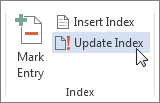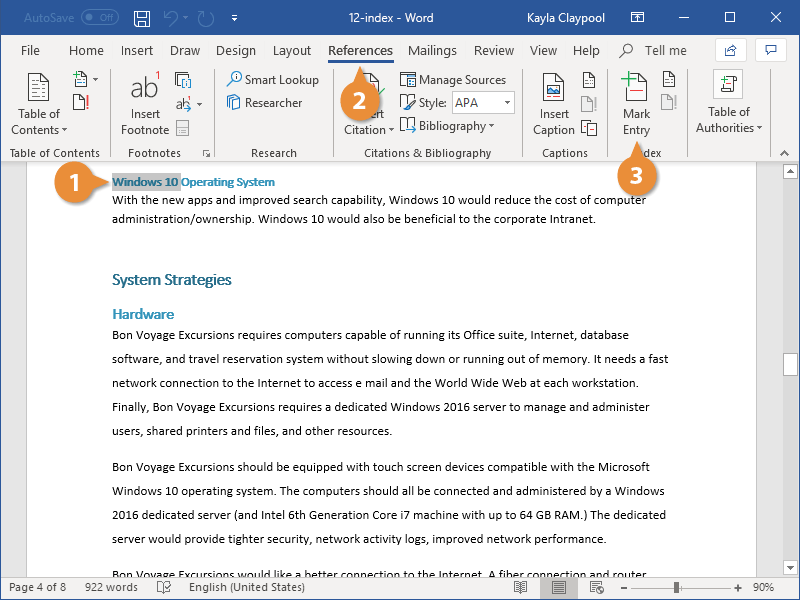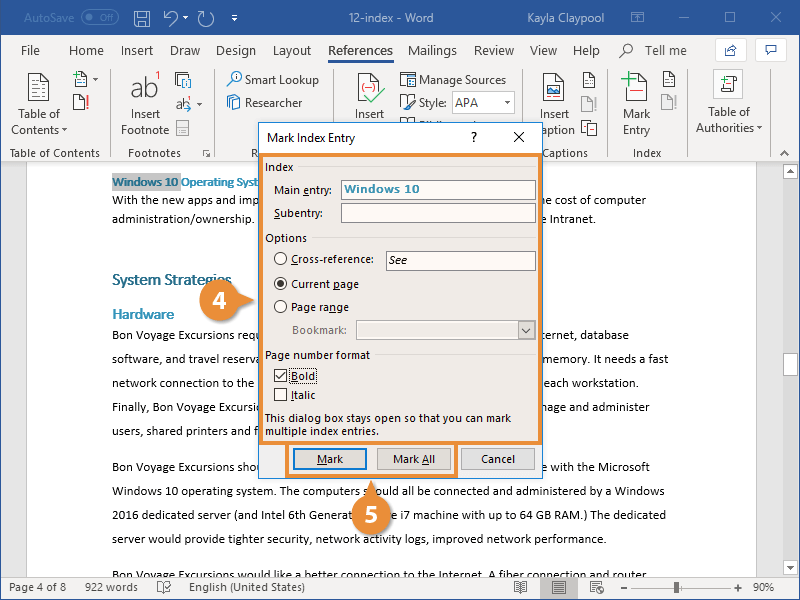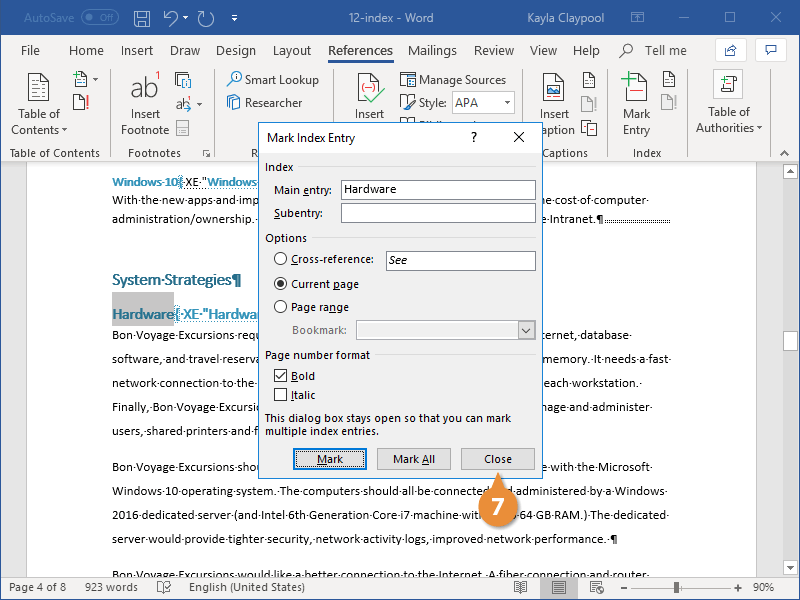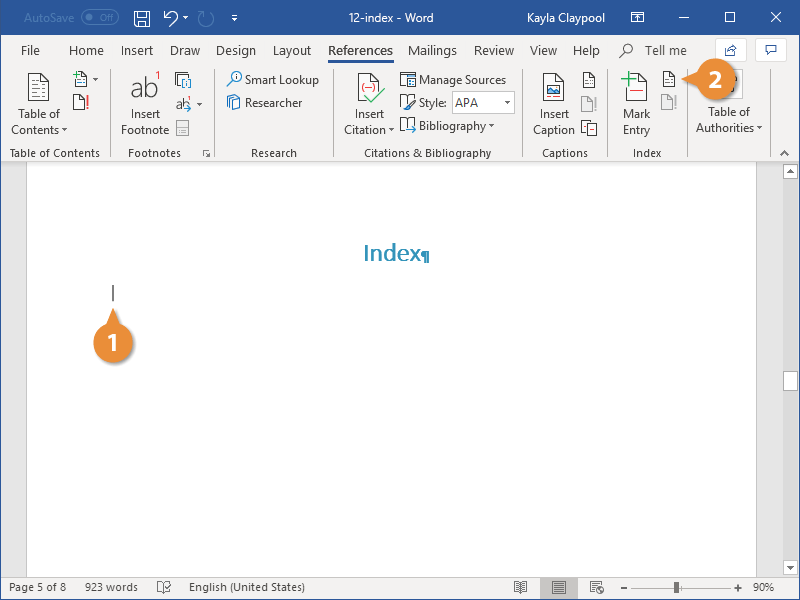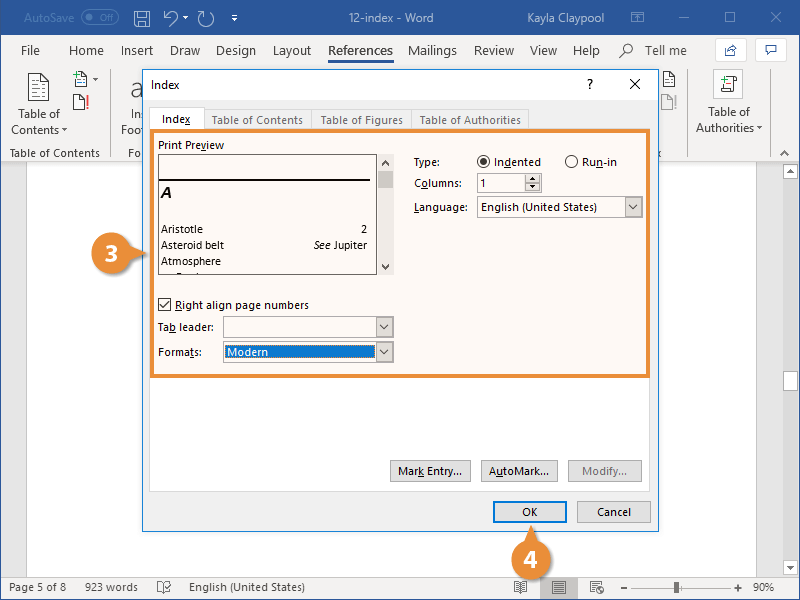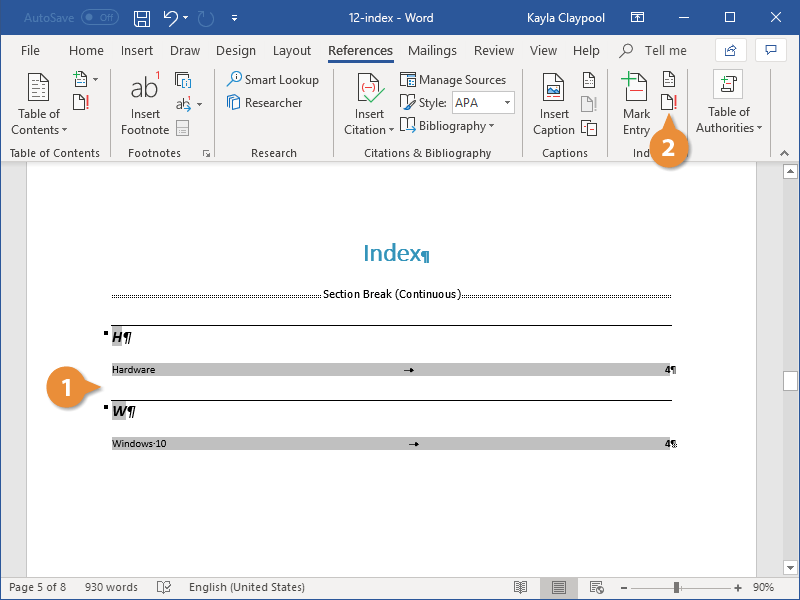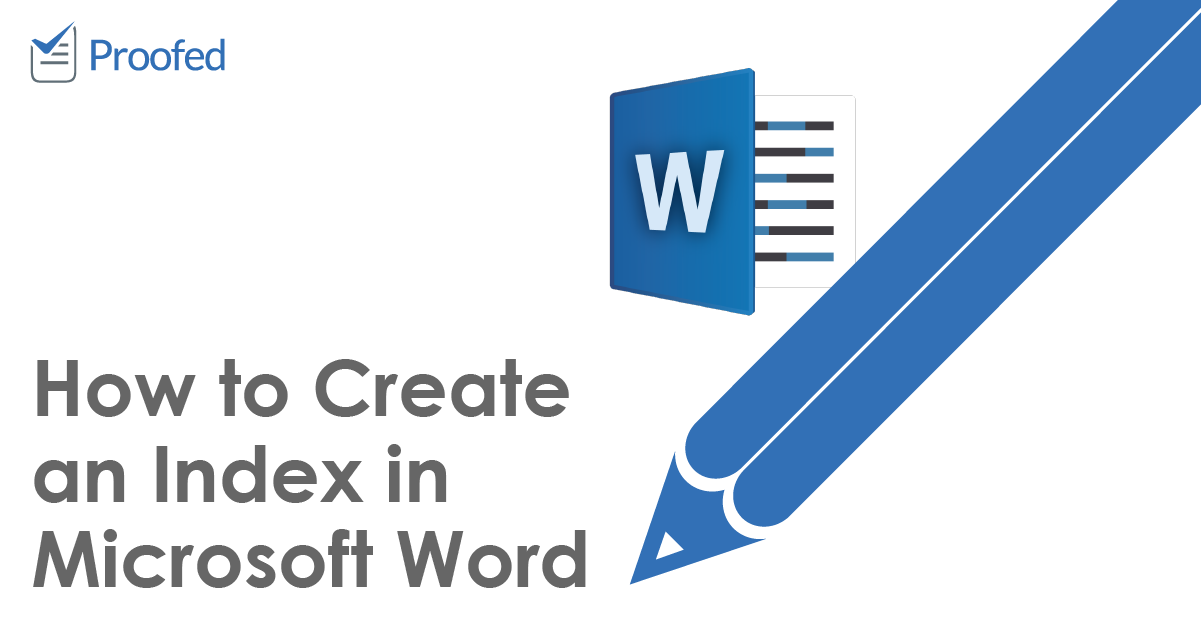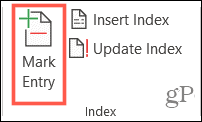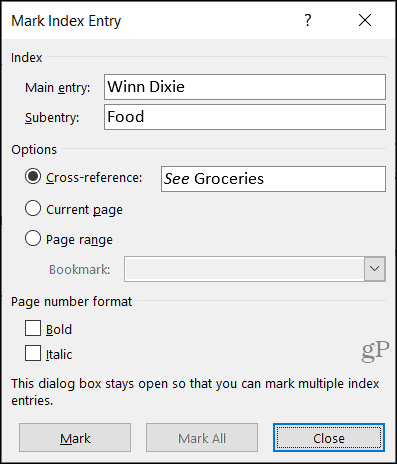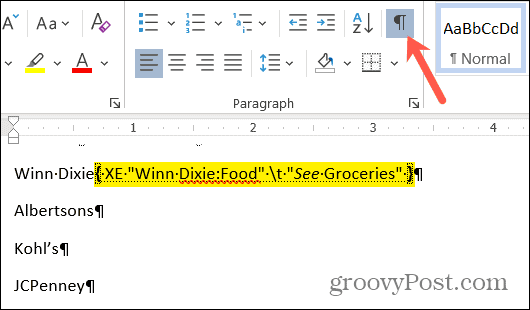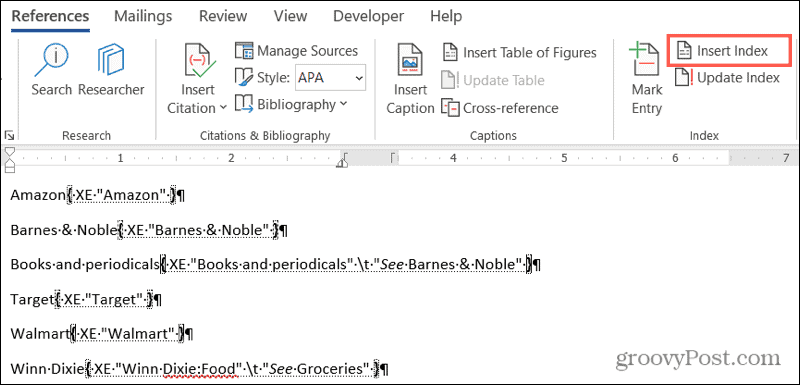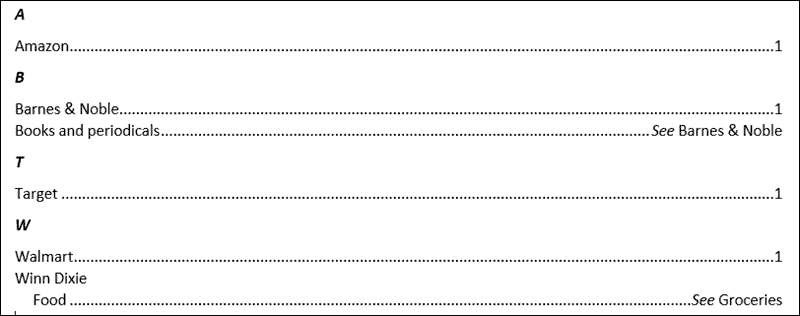Word for Microsoft 365 Word 2021 Word 2019 Word 2016 Word 2013 Word 2010 Word 2007 More…Less
An index lists the terms and topics that are discussed in a document, along with the pages that they appear on. To create an index, you mark the index entries by providing the name of the main entry and the cross-reference in your document, and then you build the index.
You can create an index entry for an individual word, phrase, or symbol, for a topic that spans a range of pages, or that refers to another entry, such as «Transportation. See Bicycles.» When you select text and mark it as an index entry, Word adds a special XE (Index Entry) field that includes the marked main entry and any cross-reference information that you choose to include.

After you mark all the index entries, you choose an index design and build the finished index. Word collects the index entries, sorts them alphabetically, references their page numbers, finds and removes duplicate entries from the same page, and displays the index in the document.
Mark the entries
These steps show you how to mark words or phrases for your index, but you can also Mark index entries for text that spans a range of pages.
-
Select the text you’d like to use as an index entry, or just click where you want to insert the entry.
-
On the References tab, in the Index group, click Mark Entry.
-
You can edit the text in the Mark Index Entry dialog box.
-
You can add a second-level in the Subentry box. If you need a third level, follow the subentry text with a colon.
-
To create a cross-reference to another entry, click Cross-reference under Options, and then type the text for the other entry in the box.
-
To format the page numbers that will appear in the index, select the Bold check box or Italic check box below Page number format.
-
-
Click Mark to mark the index entry. To mark this text everywhere it shows up in the document, click Mark All.
-
To mark additional index entries, select the text, click in the Mark Index Entry dialog box, and then repeat steps 3 and 4.
Create the index
After you mark the entries, you’re ready to insert the index into your document.
-
Click where you want to add the index.
-
On the References tab, in the Index group, click Insert Index.
-
In the Index dialog box, you can choose the format for text entries, page numbers, tabs, and leader characters.
-
You can change the overall look of the index by choosing from the Formats dropdown menu. A preview is displayed in the window to the top left.
-
Click OK.
Edit or format an index entry and update the index
If you mark more entries after creating your index, you’ll need to update the index to see them.
-
If you don’t see the XE fields, click Show/Hide
in the Paragraph group on the Home tab.
-
Find the XE field for the entry that you want to change, for example, { XE «Callisto» t «See Moons» }.
-
To edit or format an index entry, change the text inside the quotation marks.
-
To update the index, click the index, and then press F9. Or click Update Index in the Index group on the References tab.
If you find an error in the index, locate the index entry that you want to change, make the change, and then update the index.
Delete an index entry and update the index
-
Select the entire index entry field, including the braces ({}), and then press DELETE.
If you don’t see the XE fields, click Show/Hide
in the Paragraph group on the Home tab.
-
To update the index, click the index, and then press F9. Or click Update Index in the Index group on the References tab.
Need more help?
Download Article
Download Article
- Marking Your Entries
- Inserting the Index Page
- Editing Index Entries
- Video
- Q&A
- Tips
|
|
|
|
|
This wikiHow teaches you how to build an index page for your Microsoft Word document. Microsoft Word comes with a built-in indexing tool that can automatically create an index based on the entries you choose. All you’ll need to do is use the Mark Entry tool to mark each word or phrase you want to add to the index. Terms in your index can point to specific pages in the document or cross-reference to other indexed entries.
-
1
Open a Microsoft Word document. MS Word lets you add an index to any document regardless of its length, style, or subject matter. Before you can add an index to your document, you’ll need to go through each page to mark the terms you want to appear in the index.
-
2
Select a word or a group of words for your index. You can select a word or phrase by highlighting it with your mouse.
Advertisement
-
3
Click the References tab. It’s on the toolbar at the top of Word.
-
4
Click the Mark Entry button. Depending on your version of word, this icon will usually appear in a panel on the toolbar labeled «Index.» It’s the icon of a sheet of paper with a minus sign and a plus sign.[1]
-
5
Change how the word or phrase appears in the index. You’ll see the word or phrase you selected in the «Main entry» field at the top of the window. As of now, this is how that word or phrase will appear in the index you’ll be creating. If you want to change the wording, capitalization, or other parameters, you can do so by editing the text in the «Main entry» box.
- If you want to adjust the font face, size, style, or color of this entry in your index, you can do so here. Just highlight the word or phrase in «Main entry,» right-click the highlighted area, and then select Font. Make any changes you want to the font and then click OK.
-
6
Add a subentry (optional). Think about main entries as being their own lines in your index. A subentry would appear below its main entry in the index. It might be helpful to go through your document and create main entries first, and then go back and add subentries.
- For example, if you selected the word surnames and plan to index all surnames in your document, you may want to add mark each surname in the document with the «Surnames» main entry, and then list the surname itself as the subentry.
- You could also add a third-level entry, which would appear below a subentry in the index. To do this, just type a colon after the subentry and then type the third-level entry.
-
7
Choose the location referenced in the index entry. When Word builds an index based on your marked entries, it will simply list the page number on the entry you selected by default. For example, if you highlighted the word «Surnames» on page 2, the index will list «page 2» as the location of the Surnames entry. This is because «Current page» is the default selection in the «Options» section.
- If you’d rather the selected entry reference a different entry (think of when you see «See also» in an index), select «Cross-reference,» and then type the name of the other entry next to «See.»
- If you want the entry to point to a range of pages rather than a single page, you’ll need to create a bookmark for that page range. If you have a bookmark, select «Page range,» and then select your bookmark from the drop-down menu.
-
8
Format the page numbers in your index. Under the «Page number format»‘ heading, choose whether to display the page numbers in Bold and/or Italics as needed.
-
9
Click Mark to save your new entry. This button will mark the highlighted term and add it to your index with its corresponding page number, range, or cross-reference.
- After marking an entry in the index, paragraph markers will turn on immediately, and you’ll see the selected word or phrase in your document surrounded in curly braces with special formatting, much like this:
{XE "entry"} - If it’s too confusing for you to see your document in this format, you can switch back to the standard view by clicking the Home tab and then clicking the paragraph symbol ¶ in the toolbar.
- If you want to mark all instances of the same word or phrase throughout your document, you can click the Mark all button at the bottom. This would add the page number for all instances of this word or phrase to its entry in the index.
- After marking an entry in the index, paragraph markers will turn on immediately, and you’ll see the selected word or phrase in your document surrounded in curly braces with special formatting, much like this:
-
10
Continue marking entries. The «Mark Index Entry» window stays open after you mark an entry, which makes it easy to move to the next entry you want to mark. To continue, highlight another term in your document, and then click the «Mark Index Entry» window to add it to the «Main entry» field. After customizing this entry to your liking, click Mark to save it and move to the next.
- After marking your main entries, go through and mark any subentries or third-level entries. It’s kind of awkward to do:
- Highlight the word or phrase you want to list as a subentry. Using our surname example, let’s say you created a main entry for Surnames and want to add the surname «Williams» to the list of surnames in the index. Start by highlighting the first instance of «Williams» in your document.
- Next, click the Mark Index Entry window. This adds «Williams» to the «Main entry» field (for now).
- Type or paste the subentry (Williams, in our example) into the subentry field.
- Replace the text in the «Main entry» field with the name of the main entry (Surnames, in our example).
- Edit any details and click Mark (or Mark all).
- After marking your main entries, go through and mark any subentries or third-level entries. It’s kind of awkward to do:
Advertisement
-
1
Click your mouse cursor where you want to place the index. In most cases, you’ll want to place your index at the end of the document—just scroll down and click the first empty line below your existing content.
-
2
Click the Insert tab. It’s at the top of Word.
-
3
Insert a Page Break so the index is on its own page (optional). You’ll usually want your index to appear on its own page at the end of the document. To ensure that this happens, click the Insert tab and select Page Break on the toolbar to add a new page for your index.
-
4
Click the References tab. It’s at the top of Word.
-
5
Click the Insert Index button. This button is located next to the Mark Entry button on the References toolbar. This opens a window titled «Index.»
-
6
Select your index type. You can select Indented or Run-in at the top-right corner of the window. An indented index will be easier to navigate for readers, whereas a run-in index will take up much less space on the page.
- As you make changes to the index, you’ll always see a preview in the «Print Preview» box at the top-left corner of this window.
-
7
Choose the number of columns. Your index will appear in two columns by default, but you can select a different number by clicking the up or down arrows next to the «Columns» field.
- If you click the down arrow enough times, the value will change to «Auto,» which will automatically adjust the column numbers to best fit the amount of content in the index.
-
8
Select an index design from the «Formats» menu. This drop-down menu is below the Print Preview image. Select any of the designs from the drop-down menu to customize your index’s appearance.
- You can also create your own design by selecting From template and clicking the Modify button at the bottom-right. This lets you customize fonts, spacing, and style for all entries and subentries to create your own design format.
- If you want the page numbers to be aligned on the right instead of right after each entry, check the box next to «Right align page numbers.»
-
9
Click OK to save your index. This creates an index that contains all of the entries you’ve marked throughout your document. You can use this index to look up the pages where important terms and concepts are mentioned throughout your writing.
Advertisement
-
1
Click the Home tab. It’s at the top of Word. If you’ve found an error in the index, such as a misspelling or incorrect term, you can correct the errors by hand and then update the index using the Update Index tool.
-
2
Scroll to the error you want to correct. First, if you’re not in paragraph view, click the Home tab and then click the Paragraph icon ¶ to display them.[2]
Then, scroll to the «XE» entry for the entry you want to correct. Remember, all indexed references start with «XE» and are surrounded by those curly braces you saw earlier. -
3
Make your changes.
- Change the text inside the quotation marks: If the text is incorrect, correct it now by editing what’s inside of the quotes.
- Delete an entry: If you want to completely remove an entry from the index, select the entire index entry field (including the curly brackets) with your mouse, and then press your keyboard’s Delete key.
- You can click the Paragraph icon in the Home tab when you’re finished to turn off paragraph markers.
-
4
Scroll down and click your index. Now that you’ve made changes to the index, you’ll need to update it. Clicking the index selects it for updating.
-
5
Press the F9 key on the keyboard. Depending on your keyboard, you may have to press the Fn key as well to use the F9 key. This updates the index to reflect your changes.
- If that doesn’t work, click the References tab, and then click Update Index on the toolbar.
Advertisement
Add New Question
-
Question
How do I create an index which includes the pages that the words show up on?
Create the index. Click where you want to add the index. On the References tab, in the Index group, click Insert Index. In the Index dialog box, you can choose the format for text entries, page numbers, tabs, and leader characters. You can change the overall look of the index by choosing from the Formats dropdown menu.
-
Question
How many entries can I index?
You can create an index entry for an individual word, phrase, or symbol, for a topic, a special XE (Index Entry) field that includes the marked main entry.
-
Question
How do I set up an index page at the beginning of my document?
Position the insertion pointer where you want the index to appear. If you want the index to start on a new page, create a new page in Word. Click the References tab. In the Index group, click the Insert Index button. Click the OK button to insert the index into your document.
See more answers
Ask a Question
200 characters left
Include your email address to get a message when this question is answered.
Submit
Advertisement
Video
-
If you mark more entries in your document after inserting the index and they don’t appear automatically, click the index and press the F9 key on the keyboard.
-
Marking index entries will automatically turn on the Show all nonprinting characters option. You can turn this off anytime by clicking on the paragraph icon on the Home tab.
Thanks for submitting a tip for review!
Advertisement
About This Article
Article SummaryX
1. Click References.
2. Click Mark Entry.
3. Select a word for the index.
4. Click the «Mark Index Entry» box.
5. Format the page numbers.
6. Format the text.
7. Click Mark.
8. Click Mark All.
Did this summary help you?
Thanks to all authors for creating a page that has been read 424,443 times.
Is this article up to date?
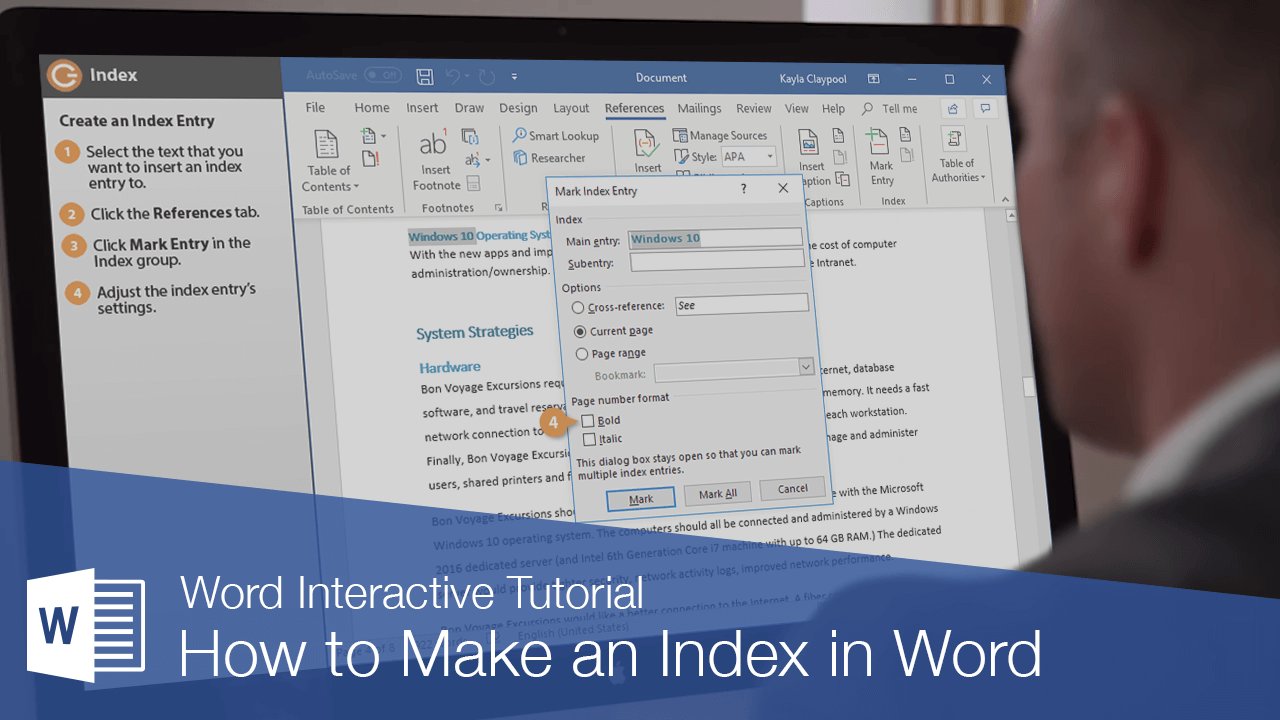
An index can usually be found at the end of a document, listing the key words and phrases in a document, along with the page numbers they appear on. There are two steps involved in creating an index: defining which words you want to appear in the index and then inserting the index.
Insert an Index Entry
- Select the text you want to include in the index.
- Click the References tab.
- Click the Mark Entry in the Index group.
- Adjust the index entry’s settings and choose an index entry option:
- Cross-reference: Adds a reference to another index entry, instead of listing the current page number.
- Current page: Lists the current page number for the selected index entry. This is the default option.
- Page range: Lists the range of pages that are included in the bookmark that you click in the Bookmark list. Before using this option, you’ll need to create a bookmark of the selected range.
- Click the Mark or Mark All button.
- Repeat the process for your other index entries.
- Click Close when you’re done.
The Mark Index Entry dialog box opens, where you can set up how the index entry works. The main entry field is filled with the selected text, and you can also add a subentry that will appear below the main entry.
Clicking Mark will create an index entry for the selected instance of the word. Clicking Mark All will instead create an index entry for every instance of the selected word throughout the document.
Once you mark an entry, formatting marks will be displayed so that you can see the hidden text that marks index entries. The window remains open, so you can continue to mark index entries throughout the document.
Index entries are invisible and will not be printed. However, you can see them when the paragraph marks are turned on.
Insert an Index
Once index entries have been marked, you’re ready to insert the index.
- Click in your document where you want to insert an index.
- Click the Insert Index button on the References tab.
- Customize the appearance and behavior of the index.
- Click OK.
Indexes usually appear at the end of a document and can take up a lot of space, so a blank page at the end is ideal.
The Index dialog box opens, where you can set up how the index will appear.
You can choose whether to right align page numbers and select a tab leader that appears between text and page numbers. You can also select whether to use a document’s formatting theme or select another one.
You can choose whether subentries will be indented below the main entry or shown run-in style in a paragraph below the main entry.
Any changes you make to the index appearance will be shown in the Print Preview.
The index is inserted, automatically filling itself out with all the index entries in the document.
Update an Index
When you insert an index, it automatically adds every index entry in the document. If you add or modify index entries after the index is created, you’ll need to update the index.
- Click anywhere in the index.
- Click the Update button.
The index is updated, adding any newly created entries while updating the page numbers for any entries that may have moved.
FREE Quick Reference
Click to Download
Free to distribute with our compliments; we hope you will consider our paid training.
We’re going to talk about creating indexes in Microsoft Word. ‘Real’ books often have an index at the back which Word can create for you.
An index is a list of terms or topics that can be found within the document. Microsoft Word has the ‘fixings’ to make an index and automatic options to take some of the drudgery

These days, indexes aren’t as common as they once were. Online documents (in Word format, web pages or PDF) can be easily searched using Ctrl + F, making an index less needed.
Indexes still have a place, especially in printed books. Unfortunately, creating an index in Microsoft Word can be difficult and time-consuming to do on a large scale. This isn’t a slight against Word whose features are mostly adequate, but rather a testament to a conceptually difficult process that needs human judgement. There are professional indexers for a reason.
Hence this series in Office for Mere Mortals, starting this week with the basics; setting up a document to be indexed and then making a simple index.
Word’s Indexing features have barely changed in well over twenty years! Some button positions have moved but the core technology, field codes and shortcut are the same as in Word 6 from 1993.
Indexing in Word – the overview
In short, here’s how indexing works in Word.
Entries are created by selecting parts of the text and adding an Index Entry. They are hidden from normal views of the document but do show up with the right settings.
This is an Index Entry {XE} for the term ‘Sherlock Holmes’.

The Index itself is made by Word which compiles all the {XE} entries into a list like this:

The {XE} we added above, appears in the Index as a reference to page 1 in the text.
Word has some dialog boxes to make formatting the index easy but underneath that is a field code.

Don’t panic … we’ll explain all this as we go along.
Preparing your first Index
Before jumping in at the deep end, we recommend that you first create a copy of your document (or another smaller document) to practice upon without having to worry about messing up the real thing. A file with a large index can get extremely complicated and confusing if you’re not certain about what you’re doing.
When you have grasped both the fundamental and, perhaps, more complex indexing techniques, come up with a method that suits your needs, then you can transfer your knowledge onto the real document without any problems.
Creating an index for an existing document involves two distinct steps:
- marking index entries
- generating the index
Making or marking a simple Index Entry
An index entry is a Microsoft Word “field code” that marks specific text for inclusion in an index. When you mark text as an index entry, Word inserts an { XE “Index Entry” } field formatted as hidden text.
To use existing document text as an index entry, first select a word or phrase that you wish to include in your index or just place the cursor at the right-place in the document. To enter your own text as an index entry instead, simply click where you want to insert it.
Use the Alt + Shift + X keyboard shortcut to insert index entries.
On the ribbon, go to “Reference | Index | Mark Entry” to bring up the “Mark Index Entry” dialog box.

The Mark Index Entry dialog box provides “Main entry” and “Subentry” boxes.
Main Entry
Most terms will fall under the “Main entry” category – a single term with its corresponding page number(s). The selected text is automatically inserted but you can change that, and often will.
Sub-entry
Or use the “Main entry” as a general heading or category for a collection of other terms otherwise known as subentries. For example, the main index entry “Animals” could have subentries “Birds” and “Mammals” – each which would be entered separately.
Here we’ve given Dr Watson a sub-entry for his weapon of choice.

Which appears in the index like this, below and usually indented from the main entry.

Add a few index entries then you’re ready to make your first index.
A short aside for our Mac friends. According to Microsoft’s documentation, Word for Mac doesn’t have ANY in-built shortcut for Mark Index entry. No we could not beleive it either so we dug a little deeper.
There is an in-built Mark Index Entry shortcut Command + Option + Shift + X. It’s listed at Tools | Customize Keyboard.
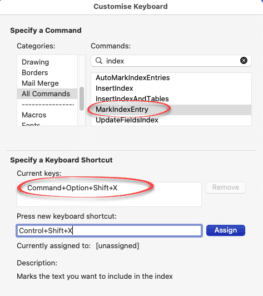
If you think that shortcut is clumsy (we do), try changing it to Control + Shift + X . That’s the closest we could get to the Winword shortcut (Alt+Shift+X isn’t possible in Word for Mac).
Show all
After marking an index entry, you will notice that the show hidden text and show all character options have both been enabled by Word. That’s so you can see and find index entries.

{XE} is the Word field code for Index Entry.
In the double-quotes is the index label. Each sub-level is separated by a colon e.g. “Dr Watson:Revolver” is the Main and Sub entry.
b is the switch to add Bold formatting to that index entry. We’ll look at other switches later.
Create a simple Index in Word
Now there’s a few index entries in the document, let’s make an index from them.
Click the cursor at the end of your document (or wherever you want your index to appear), then navigate to “Reference | Index | Insert Index”
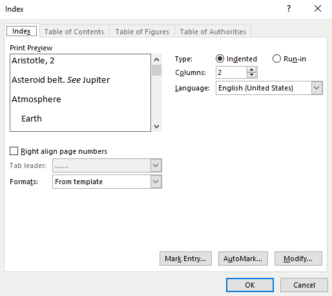
The Index dialog gives you a number of formatting options. The current formatting settings are displayed in the “Preview” pane.
Type: Indented or Run-in
The “Type” radio-button allows you to specify either an “Indented” or “Run-in” type of hierarchical display. You’ve already seen the common Indented index, here’s the run-in alternative:

Run-in takes less vertical space than Indented.
Columns
Another way to save space with an index is adding columns.
The “Columns” box allows you to specify the number of columns that the index will be displayed on per page. It’s much the same as Word’s normal multi-column support but lacks some of the column formatting choices.

The columns can be adjusted from the ruler. If you want better column control (like vertical lines between columns), try inserting multiple columns from the Layout tab then putting a single column index inside the multi-column section.
Right align page numbers
“Right align page numbers” checkbox gives more of a “Table of Contents” look to the index.
Tab leader are the characters between the entry and page number, they guide the eye along the line.

Index Formats
The “Formats” drop down box gives you a number of pre-defined styles to choose from that can be seen in the preview pane. The available styles haven’t changed much over the years, in Word 365 are:
- From template
- Classic
- Fancy
- Modern
- Bulleted
- Formal
- Simple
To design a custom style click the “Modify” button, choose a style and customize as you see fit.
When you are happy with your index layout as it appears in the preview pane, click the “OK” button and your index will be displayed in all its glory.
If you have made any changes to your index entries, always remember to click anywhere on your index and press F9 for those changes to appear in the index itself. Or right-click then Update Field.
That’s enough to get you started. In future articles we’ll look at the many hidden options in Word’s indexing plus some of its shortcomings.
Outlook is stopping Windows Indexing and how to fix it
How to STOP a specific document from being searched / indexed?
Match and Index lookup in Excel
Have you ever wondered who compiles the indexes at the end of books? Traditionally, this has been a specialist profession. However, these days, you can add an index to a document yourself. In this post, for example, we’re looking at how to create an index in Microsoft Word.
When to Add an Index
Most documents don’t need an index. In fact, it is usually only book-length non-fiction that does! And even if you are writing a non-fiction book, indexing is often handled by the publisher.
However, if you want to self-publish a work of non-fiction – or if you are creating another long document such as a company handbook – you may want to add an index yourself. And this is where the indexing options in Microsoft Word become very useful. This process involves two steps:
- Marking terms that you want to appear in the index
- Generating the index itself
We’ll now look at how to create an index in more detail below.
How to Mark Entries
Most of the work of creating an index comes with marking text. This means going through the document to look for terms you want to include in the final index. To mark an entry:
Find this useful?
Subscribe to our newsletter and get writing tips from our editors straight to your inbox.
- Use the cursor to select the word/phrase you want to include in the index
- Go to References > Index on the main ribbon and click Mark Entry
- In the new dialogue box, select the options required
- Click Mark to mark the term selected or Mark All to mark every use of the term throughout the document
The options in the Mark Entry dialogue box mentioned above will let you:
- Link a Subentry (i.e., a similar term) to the main term
- Cross-reference a term with another index entry
- Control the page number format
Make sure to do this for every term that you want to include in the index. If you need to “unmark” a term, you will first need to turn on hidden text in Word. You will then be able to see, and if required remove, the index entry in curly brackets. Make sure to do this for all similar entries.
How to Create an Index
Once you have marked your entries, all that’s left is to create an index:
- Place the cursor where you want to create an index
- Go to References > Index and select Insert Index
- Select any required formatting options from the menu
- Click OK to insert an index in the selected location
Microsoft Word will generate an index based on your marked entries. If you change any of the marked entries, you can then update the index at the click of a button by going to References > Index > Update Index.
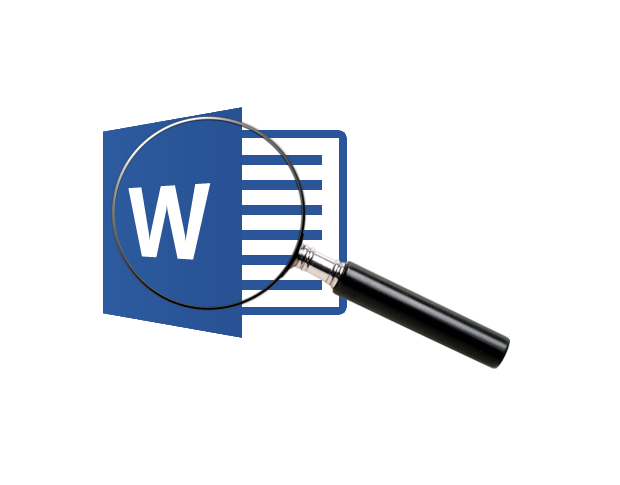
A document’s table of contents is predictable and generally reliable. An index, on the other hand, can be helpful or disappointing, because the creation process isn’t as established. There are few rules to determine what an author should or shouldn’t include in an index. Too many or too few entries will confuse and frustrate your reader. In this article, we’ll discuss the process for generating a helpful index in Word and some of the choices you’ll need to make when deciding what goes in and what doesn’t.
When working through the indexing example, you can use any document — or you can download the example .docx or .doc file. Figures and instructions are in Word 2010, but you should have no problem applying instructions to Word 2003 through 2013.
A little background
A good index is more than a list; a good index is intuitive and consistent, and that takes a specialized skill. Although Word’s indexing feature is powerful and easy to implement, the key to a good index is more plan than execution.
Word will help you create a concordance or a mark-up index. A concordance is an alphabetical index of the principal words in a book or document; an index is a list or relative entries in alphabetical order. What’s the difference? A concordance is a collection of words whereas an index lists (related) items that have meaning within the context of the written work. An index shows the result of some analysis or knowledge of the work. You’ll create a concordance only when you have a specific reason for doing so, and we won’t cover the process for creating a concordance in this article.
A mark-up index takes more planning but produces a more intuitive and context-reliable reference. This type of index requires an expertise in the subject because you tag the entries in the actual document. When you generate the index, Word uses those tags to determine what makes the index. It takes more effort or your part, but the results are more helpful to readers.
You’ll often see cross-references, which come in two flavors: See and See also. A See reference points to the correct location for a reference that isn’t defined at that location. Instead of finding nothing, the index refers the reader to another entry. This type of reference can be annoying, so use them wisely. If there’s nothing of contextual value at that location, why include the entry at all? See also references related entries that the reader might find useful in addition to the current entry. The document’s length, subject, and complexity will drive your decision to use cross-references.
Think ahead
Before you start marking up the document, you need a plan. If your organization has index conventions, you have a plan already. If not, here are a few things to consider:
- Will you cross-reference? If so, will you include See references?
- How will you handle (grammatical) articles such as The and A?
- How will you sort numbers — alphabetically or numerically?
- How will you display references that span more than a single page?
- Will you index the table of contents and other headings?
There’s no right or wrong, unless your content dictates otherwise. Your readers will adjust to your choices quickly enough if you’re consistent. Whether you tag as you write or after the document is done is also up to you, although giving the index your full attention after the writing is done might produce a more thorough index. More importantly, the visual tags are distracting to the creative process. My advice is to tag after you’re done writing, editing, and formatting the document.
Index tags are case- and space-sensitive. In other words, the terms “Cardinal” and “cardinal” aren’t the same; both will appear in your index. Similarly, “Cardinal” and ” Cardinal” won’t sort together. The space character at the beginning of the latter will force that entry to the top of the index. So, when you start tagging, tag carefully and consider these two sensitivity issues. If something’s out of place, one of these two issues might be the culprit.
Mark the text
After planning the contents for your index, you’re ready to start tagging, as follows:
- Select the term you want to index. In this example, select the phrase Insert tab in the first line of the first paragraph (Figure A). As you can see, the highlight doesn’t include the space before or the comma and space that follow the phrase.
Figure A - Click the References tab, and then click Mark Entry in the Index group — or press [Shift]+[Alt]+[x]. In Word 2003, choose Mark Index Entry on the Insert menu. (If this command isn’t available in Word 2003, use the keyboard shortcut or see the Word 2003 command below.)
- Click Mark (Figure B).
Figure B
The resulting tag is shown in Figure C.
Figure C
Word visually identifies tagged text.
The tag { XE “Insert tab” } is a specialized field that includes the marked text and additional attributes, such as cross-referencing. In this simple example, we didn’t change any of the defaults. We didn’t add a cross-reference or apply any special formatting. You could make other choices. In a document with many tab references, you might want to make Tab the main entry and Insert a subentry. You might even want to do both — and if you do, cross-references might be in order.
Add a second index tag by marking galleries in the first line, as shown in Figure D. This time, replace the galleries with gallery in the Main entry control and then click Mark All.
Figure D
You can tag a term and change the entry.
As you can see in Figure E, the tag contains the word gallery instead of galleries. Although gallery is the index entry, the index will reference locations for galleries. In addition, by clicking Mark All, you tagged all instances of the term galleries in your document, except in the table of contents and headings.
Figure E
The second tag is different.
Now, let’s look at a more complex entry — Quick Styles in the second paragraph. In Word terminology, Quick Styles is a gallery. As such, it would be reasonable to include two entries: one for Quick Styles, and again under gallery.
- { XE “Quick Styles” t “See also gallery” } Click Cross-reference in the Options section and add the text See also gallery to add a cross-reference to gallery for the main entry Quick Styles. The t flag denotes a cross-reference.
- { XE “gallery:Quick Styles” } Enter gallery as the Main Entry text and Quick Styles as the Subentry text to enter Quick Styles as a subentry to gallery.
Figure F shows the result of adding two index tags:
Figure F
The same text can be marked to create subentries and cross-references.
Word 2003 command
If you’re still using Word 2003 and the Mark Index Entry command isn’t on the Insert menu, you can use the keyboard shortcut to open the Mark Index Entry dialog — or add the command to the Insert menu as follows:
- Choose Customize from the Tools menu, and then click the Toolbars tab.
- Make sure Menu Bar is checked in the Toolbars list (it’s a default, so it should be checked).
- Click the Commands tab.
- In the Categories list, click All Commands.
- In the Commands list, select MarkIndexEntry and drag the command to the Insert menu.
- Drag the command icon to the location where you want to the command to appear on the menu and release it.
- Close the Customize dialog.
Generate the index
There are several terms and phrases we could index in this short document, but let’s move on now and generate an index. Position the cursor at the end of the document (you’ll probably add a new page to your document). In the Insert group (still on the References tab), click Insert Index. In Word 2003, choose Reference from the Insert menu and then choose Index and Tables. The default settings are adequate for the first run, but change the Columns to 1, as shown in Figure G.
Figure G
Generate a one-column index.
You’ll find a one-column index, similar to the one shown in Figure H, which is easier to proof and edit. The index includes your tagged entries and the page number on which they occur. The index also inserts a section break automatically. (I added the Index label, not Word.)
Figure H
The index is the result of your tags.
Entries are in alphabetical order. The first entry, gallery, occurs on page 1 but also has a subentry, Quick Styles. The main entry for Quick Styles entry has a cross-reference to gallery. Remember to be consistent. For example, if you marked another gallery, such as the Styles gallery, you’d want to add it to the gallery entry as a subentry and to cross-reference the gallery entry in the Styles main entry. Consistency is the key to generating a readable and helpful index.
Modifying the index
Unless you’re an index master or you’re indexing a simple document with only a few entries, the chances are that you won’t get things right the first time. For instance, you might have noticed that the Quick Styles main entry has a cross-reference but no page number. If you review Figure F, you’ll notice that you can add a page number of a cross-reference in the same tag, but not both. You need another tag to include a page number for the Quick Styles main entry.
You can’t modify the index directly. Instead, modify the index tag in question or add a new one. Then generate a new index. In this case, add a main entry tag for Quick Styles by highlighting Quick Styles in the document and adding a main entry tag as shown in Figure I. After closing the Mark Index Entry dialog, generate a new index. You don’t have to worry about position; Word will replace the existing index. When Word prompts you to confirm this action, click OK. In the resulting index, Quick Styles has a page number and a cross-reference.
Figure I
A main entry can have a page number and a cross-reference.
Extras
You’ve learned a lot, but there’s much more. There are several options you can use to create a more advanced index. For instance, you can create a second subentry by separating text with a colon character (:). Third-level entries (and further) are seldom necessary, but Word will let you create as many levels as you need.
You can format entries in several ways:
- In the Mark Index Entry dialog, use the Page number format options to format page numbers.
- In the tag, apply formats to the entry text.
- In the tag, use flags (which I’ll mention next).
There are several flags that you can insert into the tag to gain more control:
- Use b to bold the entry.
- Use i to italicize the entry.
- Use t to add a cross-reference.
- Use r to reference a bookmark (which we didn’t cover in this article). You can use this flag to create a page range.
The Mark Index Entry dialog has a button at the bottom called AutoMark. You’ll use this button to create a concordance index (which isn’t covered in this article).
You don’t have to close the Mark Index Entry dialog each time you mark an entry — that would be tedious. Leave the dialog open while you highlight terms. If the Main Entry control doesn’t update with the new text, click inside the control. After the control displays the new text, set the necessary options, and click Mark or Mark All. Repeat marking until you’re done. Then close the dialog.
Use the Show/Hide option in the Paragraph group on the Home tab to hide and display the index tags, as needed.
Send me your question about Office
I answer readers’ questions when I can, but there’s no guarantee. When contacting me, be as specific as possible. For example, “Please troubleshoot my workbook and fix what’s wrong” probably won’t get a response, but “Can you tell me why this formula isn’t returning the expected results?” might. Please mention the app and version that you’re using. I’m not reimbursed by TechRepublic for my time or expertise, nor do I ask for a fee from readers. You can contact me at susansalesharkins@gmail.com.
This Index in Word tutorial is suitable for users of Word 2010/2013/2016/2019 and Microsoft 365.
Objective
Mark entries in a long document for inclusion in the index. Create an index in Word from scratch and understand how to edit and update it.
Indexing Explained
An index lists the terms and topics discussed in a document listed in alphabetical order. It is usually located at the end of a document. It allows the reader to quickly jump to pages of interest by clicking on the page number associated with the index entry. To create an index in Word, you must first go through the document and mark points of interest as index entries. Once complete, the index can be inserted.
It is important to remember to update the index if anything in the document changes to ensure that the page numbers still correspond with the topic. Note, an Index page is different from a Contents Page!
Video Tutorial
Marking Index Entries
In this example, I have a document that spans 9 pages. It contains various headings that have been marked with Word heading styles. To create an index in Word, I first need to go through the document and mark each heading that I want to appear in the index.
- Select the heading that you want to mark
- Click the References tab
- From the Index group, click the Mark Entry button or press the Alt+Shift+X keyboard shortcut
- Review the options in the Mark Index Entry dialog box
- Click Mark
Word will automatically turn on Show/Hide, and you will see the field code behind the entry. Do not worry too much about this as it will disappear once Show/Hide is turned off again.
Continue through the document marking entries in the same way.
NOTE: You will need to click Close on the Mark Entry dialog box each time you mark an entry.
Mark Index Subentries
To add structure and hierarchy to the index, you can mark entries as subentries of main entries. These subentries will appear indented underneath the main entry they are linked to in the index.
In this example, ‘House Stark’, ‘House Lannister’, and ‘House Targaryen’ are sub-headings of ‘Cast and Characters’. I can show this hierarchy in the index by marking them as subentries. This means they will be indented in the index.
- Select the subentry text i.e. ‘House Stark’
- Click Mark Entry
- Press Ctrl+C to copy the selected Main Entry text to the Clipboard.
- Position the insertion point in the Subentry text box.
- Press Ctrl+V to paste the text into the Subentry text box.
- Change the information in the Main Entry text box to indicate the main index entry to which this subentry should be subordinate.
- Click on Mark
Continue through the document marking subentries in the same way.
Create an Index
Once you have marked all entries to be included in the index, you can add the index to the bottom of the document.
- Scroll to the last page of the document (preferably a blank page)
- Click the References tab
- From the Index group, click Insert Index
Review the options in the Index dialog box. In this example, I have chosen to right-align page numbers and use a dotted tab leader between the entry and the page number.
- Click OK
Notice that the subentries are indented.
Add an Index Heading
You may want to add a heading for your index. You may also want to include the index heading as an index entry.
- Type a name for your index and apply a heading style if desired
- Select the Index heading
- Click the References tab
- Click Mark Entry
Update an Index
To include the new entry in the index, you will need to update it.
- Click anywhere in the index
- Click the References tab
- Click Update Index
The index heading is now included in the index.
For more information about creating indexes in Word, please check out the following links:
Microsoft – Create and Update an Index
TechRepublic – How to add an index to a Word document using index tags
If you are interested in learning more about Microsoft Word, then take a look at the following free resources:
- How to Create and Print Envelopes in Word
- How to Create a Contents Page in Word
- How to Mail Merge in Word
- How to Print Labels in Word
To learn Word with Simon Sez IT. Take a look at the Word courses we have available.
Deborah Ashby
Deborah Ashby is a TAP Accredited IT Trainer, specializing in the design, delivery, and facilitation of Microsoft courses both online and in the classroom.She has over 11 years of IT Training Experience and 24 years in the IT Industry. To date, she’s trained over 10,000 people in the UK and overseas at companies such as HMRC, the Metropolitan Police, Parliament, SKY, Microsoft, Kew Gardens, Norton Rose Fulbright LLP.She’s a qualified MOS Master for 2010, 2013, and 2016 editions of Microsoft Office and is COLF and TAP Accredited and a member of The British Learning Institute.
Posted on: 07/21/2017
An index lists the terms and topics that are discussed in a document, along with the pages that they appear on. To create an index, you mark the index entries by providing the name of the main entry and the cross-reference in your document, and then you build the index.
Steps to mark words or phrases for the Index
- Select the text you want to include in the index.
- Click the References tab, in the Index group, click Mark Entry.
- Click Mark All.
- Leave the Mark Index Entry open and move it if necessary. Select the next word or phase in your document and click back in the Mark Index Entry box. Select Mark All.
- Continue until all words or phrases are marked.
- When done, click close to close the Mark Index Entry box.
- Go to the end of the document with CTRL + END. Add a page break with CTRL + ENTER on the keyboard.
- On the blank page, click Insert Index.
- Use either 1 or 2 columns, pick a format, and click OK. Finally, turn off Show/Hide with CTRL + SHIFT + 8 on the main keyboard.
YouTube Video on Creating an Index in Word
Transcript for YouTube Video on inserting an Index
Hello this is Chris Menard, let me show you today how to create an index in Microsoft Word and if you’re wondering why do I need an index, if you’re writing a ploy handbook or a technical manual, the first place people often go is to the back of the book to find a certain word or phrase that they’re looking for, and then go look at that page, so if you want to follow along, start Word, then give an equal symbol or and and then we’re going to do 25 7 enter, they’ll give you a random text go back to the top of the document — and if you have at least four pages — I’m happy if your text doesn’t match my text exactly, that’s okay too so to make an index, the first thing you do is double-click, a word go to the references tab up at the top and we’re going to use the index group.
I’m going to select mark entry — it picked up the word video which I double clicked. If I want to mark video on just this page, which is page one, you click the word mark but I want to do it throughout the entire document, so I’ll select mark all.
When you click mark all it may put this code in the back — don’t worry about it — instead of closing this and going to the next word, just move it — highlight another word click back in here and that word will appear in the main entry — mark all.
I’m gonna do Footer, double-click, click in here, mark all.
I’m going to do a couple more Words charts and people wait, may need to know if you need to do two words, I’m gonna select smart art and graphics. Click back in here… perfect!
Right here, mark all, so act like you marked all the words you want. Close if you want to get rid of this right here, go back to the Home tab, the first time you did mark entry — it turned on show/hide. You can turn it off and on all you want to — that will not print, but I’m going to turn it off. I’m gonna go to the end of the document — control end, put a page break, control enter.
You say, Chris I don’t like control enter, I’ll still with the mouse — OK so let’s do undo and then let’s go the long way — layout breaks page — that is Control + Enter, go back to references and here we go — time to put the index in here now, so step one was to mark our entries, step two is to actually put the index in, so let’s go to insert index.
You should be on the index tab. How many columns do you want? I’m gonna leave it at two. You can change the format — there’s classic, fancy, modern — I’m not going to run through all of them. I’m gonna do fancy and I’m gonna hit OK, and there’s an index because I did that equals re and it’s got the same board on all the pages so usually it’ll say charts page 1 3 4 video 1 & 4.
I’m gonna do an undo — Ctrl + Z — go back to insert index. I don’t like the two columns, I’m gonna make it one column. Click OK and there’s my index, so now you know how to create an index in Microsoft Word.
If you need Microsoft Office training please give me a call or an email. Also, my Excel training classes are online thank you
Chris Menard
Chris Menard is a Microsoft Certified Trainer (MCT) and is employed full-time as a Trainer for BakerHostetler, one of the nation’s largest law firms. Menard has a YouTube channel with over 900 technology videos covering Excel, Word, Zoom, Teams, Outlook, Gmail, Google Calendar, and other resources that over 15 million viewers have appreciated. Menard also does public speaking at conferences for CPAs and Administrative Professionals. Connect with Chris on LinkedIn at chrismenardtraining.com/linked or on YouTube at chrismenardtraining.com/youtube
Categories
-
Blog
»
Microsoft
»
Microsoft Word
»
Advanced
If you’re composing a lengthy document or book, we’ll show you how to create an index in Word. This is a handy reference for your readers.
If you’re creating a lengthy document in Microsoft Word, an index is a convenient tool for your readers. Traditionally, we see indexes in the backs of books. These handy tools allow us to look up a word or phrase to find the page referencing that topic.
Similar to a table of contents in Word, you can insert an index and then update it automatically. This takes much of the manual work out of creating these great reference sources. Here, we’ll show you how to mark your index entries, create the index, and update it in Word.
Mark Your Index Entries
Even though Word can build your index automatically, it’s not smart enough to know which items you want in it. So to create your index, you’ll need to mark the entries. This is the bulk of the work you’ll do for the index. But once you start marking entries, you’ll be able to zip through them quickly.
- Open your document in Word and head to the References tab.
- Select your first index entry by dragging your cursor through it. This can be a word or phrase.
- In the ribbon, you’ll see the Index section toward the right side. Click the Mark Entry button.
- A small pop-up window appears for you to describe your entry. And this window can remain open while you select your remaining entries.
- Enter the Main entry at the top and optionally a Subentry.
- Choose from Options for a cross-reference, the current page, or a page range.
- Optionally, you can format the page number that displays in bold and/or italic.
- Click Mark for a single entry or Mark All to mark that same text everywhere in your document.
- When you finish with the Mark Index Entry window, click Close.
On your document, index entries are labeled with “XE”. If you add a Subentry or cross-reference, you’ll notice that within the XE tag as well. If you don’t see your XE tags but would like to, go to the Home tab and click the Show/Hide Paragraph button.
Edit or Remove Index Entries
If you need to make a change to an entry, for instance, remove a cross-reference, you’ll do so within that XE field. Make your changes inside the quotation marks. Another option is to remove the marked entry and then remark it.
To remove an index entry, select all text within and including the braces ({ }) and hit Delete. You can then follow the steps above to mark the entry again with the changes you want.
When you’re ready to insert your index, move your cursor to the spot you want it in your document. Then, select the References tab and click Insert Index. Before the index is created, you have a few settings you can adjust if you like.
Print Preview: This gives you a snapshot of what the index will look like and it will adjust if you change the below settings.
Tab Leader: Certain formats (below) offer different tab leaders to choose from such as dotted lines or dashes. These come between the entry and the page number.
Formats: You can pick from different themes for your index such as fancy, modern, or formal for a pleasing appearance.
Type: Choose from Indented or Run-in for the format type. You can spot the difference in the Print Preview box.
Columns: Depending on how many entries your index has you may want to add or remove columns for the structure.
After you make your index adjustments, click OK. Your index will pop into your document with your entries. You’ll see everything nice and neat and in alphabetical order.
Update the Index
You can continue to mark additional entries after you create your index and simply update it. And if you edit or remove entries, you’ll need to update the index as well.
Click inside the index area in your document and click the Update Index button in the ribbon on the References tab. If the button is grayed out, be sure your cursor is within the index.
If you want to remove the index completely, select all of its text and hit your Delete key. You’ll then likely want to delete the index entries (above) if you don’t plan to use an index at all.
Create an Index Automatically in Word
It can take some time to mark all of the entries you want in your Word index. But an index can be a valuable tool for your readers. So consider adding one if your audience can benefit from it for your next Word document, book, or other lengthy material.
For more reference features, check out how to cite sources and create a bibliography in Microsoft Word.

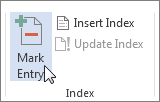
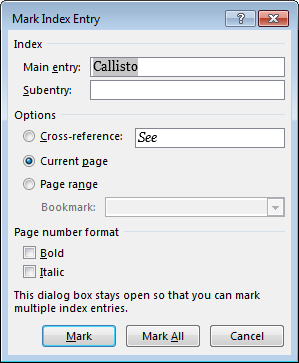
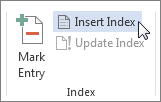
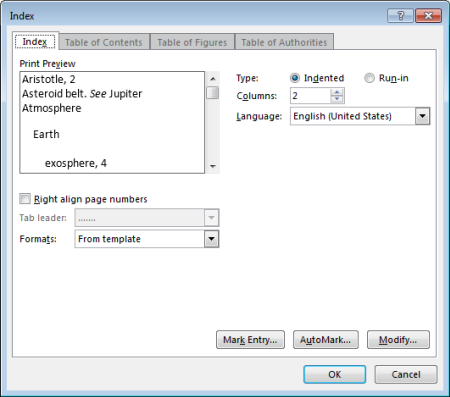
 in the Paragraph group on the Home tab.
in the Paragraph group on the Home tab.